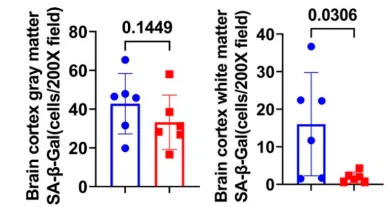A study published in Antioxidants has found that the senolytic fisetin significantly decreases cellular senescence in the brains of sheep.
A flavonoid with a long history
This paper begins with an in-depth discussion of many previous experiments involving this flavonoid, which is naturally found, in small quantities, in various fruits and vegetables such as strawberries and cucumbers. In addition to its well-documented senolytic abilities, these researchers note that fisetin has been found to exhibit positive effects in multiple species: it reduces oxidative stress in the well-known C.elegans worms [1] and improves cognitive function in rats and mice [2]. Previous pathway analysis has found that fisetin acts as a direct antioxidant, promotes the antioxidant glutathione, and reduces inflammation in brain microglia [3].
However, the majority of fisetin-related experiments have been done in cells, worms, and rodents. These researchers decided to see if fisetin was more effective in larger mammals: a dozen female Columbia sheep divided into two groups of six. The sheep were 6-7 years old, which is somewhat over half of their natural lifespan. After 8 weeks during which the treatment group received 100 mg/kg injected fisetin, the researchers examined these animals’ brains and organs.
Brain senescence biomarkers were significantly decreased
While fisetin had no visible effects on the brain morphology of these animals, a closer look revealed several significant differences. In the cortical gray matter of these sheep, cells had less of the senescence biomarker SA-β-gal, although this did not reach statistical significance. The cerebellum was also not statistically affected. However, the cortical white matter was significantly less senescent, as was one region of the hippocampus.

While most of the cells showing these biomarkers were large neurons, astrocytes were also affected. To determine which cells were affected, these researchers used two different senescence biomarkers along with markers of neuronal and astrocyte identity. These results were considerably stronger: fisetin was found to reduce cellular senesence in both neurons and astrocytes, in both grey and white matter. Many of the relevant p values were very small, despite there only being six animals in each group, demonstrating the apparent power of this senolytic.
Fisetin also decreased S100B, a plasma biomarker of neuronal injury and degeneration.
Confusing and contradictory gene expression
In contrast to the senesence biomarkers, many of of the gene expression results were relatively inconclusive if not puzzling. Inflammatory biomarkers, along with antioxidant genes and senescence-related genes, were not found to be affected within statistical significance. Inflammatory, senescence-associated interleukins were noted to slightly increase, although this did also not meet statistical significance.
In general, these gene expression results were found to be true for the spleen and heart. Interestingly, mRNA related to p53, which has been associated with senescence, was found to be increased in bone marrow.
The lung and liver, however, were different. The senescence-related genes GLB1, p21, and p53, along with the inflammatory biomarker TREM2, were decreased in the lung, although the antioxidant gene CAT was decreased nearly to nothing. In the liver, both the antioxidant genes SOD1 and CAT were decreased to near-zero levels, and the interleukin IL-8 was significantly increased. However, in that same tissue, the inflammatory biomarker NLRP3 was decreased along with GLB1 and p21.
These contradictory results demonstrate part of the reason why fisetin, despite its clear senolytic ability, is still questioned as a human therapeutic. More in-depth experiments will have to be conducted to determine where, exactly, fisetin fits into the biology of senesence in various tissues and organs.
Literature
[1] Park, S., Kim, B. K., & Park, S. K. (2022). Effects of fisetin, a plant-derived flavonoid, on response to oxidative stress, aging, and age-related diseases in Caenorhabditis elegans. Pharmaceuticals, 15(12), 1528.
[2] Maher, P., Akaishi, T., & Abe, K. (2006). Flavonoid fisetin promotes ERK-dependent long-term potentiation and enhances memory. Proceedings of the National Academy of Sciences, 103(44), 16568-16573.
[3] Maher, P. (2009). Modulation of multiple pathways involved in the maintenance of neuronal function during aging by fisetin. Genes & nutrition, 4(4), 297-307.




